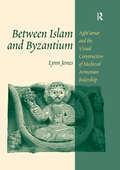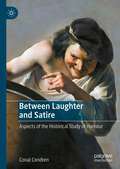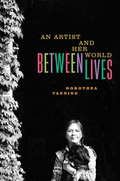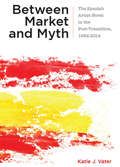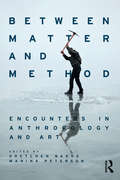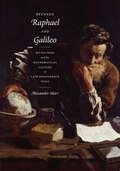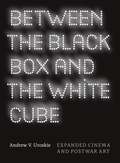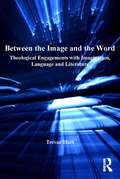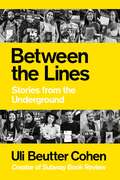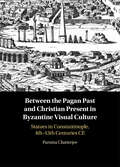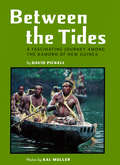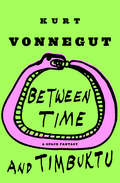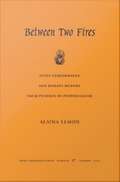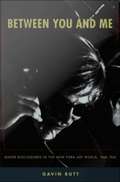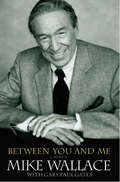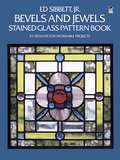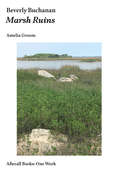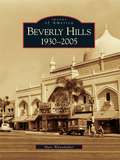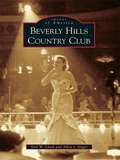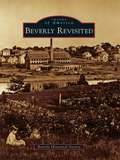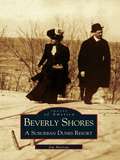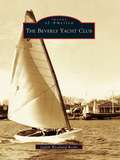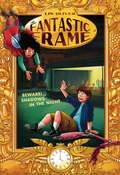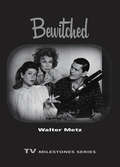- Table View
- List View
Between Islam and Byzantium: Aght`amar and the Visual Construction of Medieval Armenian Rulership
by Lynn JonesBetween Islam and Byzantium provides the first complete analysis of the development of the visual expression of medieval Armenian rulership during the years 884-1045 CE. During this period, the Armenian rulers had loosened the ties that subjected them to the Arab caliphate, but by its end the Byzantine empire had instead become dominant in the region. The influences exerted by these external, opposing powers are a major theme in this book. Lynn Jones re-contextualizes the existing royal art and architecture by integrating analyses of contemporary accounts of ceremonial and royal deeds with fresh examinations of the surviving monuments, of which the church at Aght`amar, with its famous carvings, is the prime example. Setting the art and architecture of the period more clearly in its original context, the author reveals the messages these buildings, sculptures and manuscripts were intended to convey by those who created and viewed them. This study provides a new perspective on the complex interactions between a broad range of nationalities, ethnicities and religions, shedding fresh light on the nature of medieval identity. It adds to a growing literature on the eastern neighbours of Byzantium, and opens up new issues on the relationship between the Byzantine empire and the Islamic caliphate in the medieval period.
Between Laughter and Satire: Aspects of the Historical Study of Humour
by Conal CondrenThis book explores closely related aspects of the historical study of humour. It challenges much that has been taken for granted in a field of study for which history has been marginal. It disputes the conventional genealogical view that humour theory dates from antiquity and outlines an alternative conceptual history. It critically examines the nostrum that humour is universal. It then explores the methodological difficulties in treating both verbal and non-verbal humour historically, dealing with contextualisation, intentionality, translation and reception. It explores the variable relationships between satire and definition and concludes with a detailed case study from recent history: the iconic Yes Minister and Yes, Prime Minister television comedies. These are commonly seen as realistic, but better understood as presenting popularised theories for satiric and propagandistic effect. Only in their treatment of language can we assess a putative political realism. The satires are often highly perceptive but largely dependent on misleading and inadequate theories of political discourse.Conal Condren is an Emeritus Scientia Professor at UNSW, a member of two Cambridge Colleges and a fellow both of the Australian Academy of the Humanities and The Social Sciences in Australia. He has published widely and principally in early modern intellectual history. Among his books are The Status and Appraisal of Classic Texts; Argument and Authority in Early Modern England; Political Vocabularies: Word Change and the Nature of Politics.
Between Lives: An Artist and Her World
by Dorothea TanningThe life and times of one of our most enchanting artists; a twentieth-century fairy tale, lovingly remembered and luminously told. Fourteen years ago, the artist Dorothea Tanning published Birthday, a collection of reminiscences. Now she has expanded it into a memoir of her journey through the last century as confidant, collaborator, and muse to some of its most inspired minds and personalities: a diverse assemblage that ranges from the fathers of dada and surrealism to Virgil Thompson, George Balanchine, Alberto Giacometti, Dylan Thomas, Truman Capote, Joan Miró, James Merrill, and many more. At its center is the relationship, tenderly rendered, between Tanning and her famed husband, the enigmatic surrealist Max Ernst. Whether recalling the poignant presence of her friend Joseph Cornell or simply marveling at the facades along a Venice canal, "their filmy reflections fluttering in the dirty canal like fragile altar cloths hung out to dry," Tanning's writing is beguiling, wry, and shot through with the same eye for pregnant detail and immanent magic that marks her art.
Between Market and Myth: The Spanish Artist Novel in the Post-Transition, 1992-2014 (Campos Ibéricos: Bucknell Studies in Iberian Literatures and Cultures)
by Katie J. VaterIn its early transition to democracy following Franco’s death in 1975, Spain rapidly embraced neoliberal practices and policies, some of which directly impacted cultural production. In a few short years, the country commercialized its art and literary markets, investing in “cultural tourism” as a tool for economic growth and urban renewal. The artist novel began to proliferate for the first time in a century, but these novels—about artists and art historians—have received little critical attention beyond the descriptive. In Between Market and Myth, Vater studies select authors—Julio Llamazares, Ángeles Caso, Clara Usón, Almudena Grandes, Nieves Herrero, Paloma Díaz-Mas, Lourdes Ortiz, and Enrique Vila-Matas—whose largely realist novels portray a clash between the myth of artistic freedom and artists’ willing recruitment or cooptation by market forces or political influence. Today, in an era of rising globalization, the artist novel proves ideal for examining authors' ambivalent notions of creative practice when political patronage and private sector investment complicate belief in artistic autonomy. Published by Bucknell University Press. Distributed worldwide by Rutgers University Press.
Between Matter and Method: Encounters In Anthropology and Art
by Gretchen Bakke; Marina PetersonBuilding on the lively exchange between anthropology and art that has emerged in recent years, Between Matter and Method makes a bold and creative contribution to this rapidly growing field. Taking an expansive approach to the arts, it finds commonalities in approaches that engage with visual artifacts, sound, performance, improvisation, literature, dance, theater, and design. The book questions current disciplinary boundaries and offers a new model grounded in a shared methodology for interdisciplinary encounter between art and anthropology. Gretchen Bakke and Marina Peterson have gathered together anthropologists whose work is notable for engaging the arts and creative practice in conceptually rigorous and methodologically innovative ways, including Kathleen Stewart, Keith Murphy, Natasha Myers, Stuart McLean, Craig Campbell, and Roger Sansi. Essays span the globe from Indonesia, West Virginia and Los Angeles in the United States, to the Orkney Islands in the UK, and Russia and Spain.
Between Raphael and Galileo: Mutio Oddi and the Mathematical Culture of Late Renaissance Italy
by Alexander MarrAlthough largely unknown today, during his lifetime Mutio Oddi of Urbino (1569–1639) was a highly esteemed scholar, teacher, and practitioner of a wide range of disciplines related to mathematics. A prime example of the artisan-scholar so prevalent in the late Renaissance, Oddi was also accomplished in the fields of civil and military architecture and the design and retail of mathematical instruments, as well as writing and publishing. In Between Raphael and Galileo, Alexander Marr resurrects the career and achievements of Oddi in order to examine the ways in which mathematics, material culture, and the book shaped knowledge, society, and the visual arts in late Renaissance Italy. Marr scrutinizes the extensive archive of Oddi papers, documenting Oddi’s collaboration with prominent intellectuals and officials and shedding new light on the practice of science and art during his day. What becomes clear is that Oddi, precisely because he was not spectacularly innovative and did not attain the status of a hero in modern science, is characteristic of the majority of scientific practitioners and educators active in this formative age, particularly those whose energetic popularization of mathematics laid the foundations for the Scientific Revolution. Marr also demonstrates that scientific change in this era was multivalent and contested, governed as much by friendship as by principle and determined as much by places as by purpose. Plunging the reader into Oddi’s world, Between Raphael and Galileo is a finely wrought and meticulously researched tale of science, art, commerce, and society in the late sixteenth and early seventeenth century. It will become required reading for any scholar interested in the history of science, visual art, and print culture of the Early Modern period.
Between Raphael and Galileo: Mutio Oddi and the Mathematical Culture of Late Renaissance Italy
by Alexander MarrAlthough largely unknown today, during his lifetime Mutio Oddi of Urbino (1569–1639) was a highly esteemed scholar, teacher, and practitioner of a wide range of disciplines related to mathematics. A prime example of the artisan-scholar so prevalent in the late Renaissance, Oddi was also accomplished in the fields of civil and military architecture and the design and retail of mathematical instruments, as well as writing and publishing. In Between Raphael and Galileo, Alexander Marr resurrects the career and achievements of Oddi in order to examine the ways in which mathematics, material culture, and the book shaped knowledge, society, and the visual arts in late Renaissance Italy. Marr scrutinizes the extensive archive of Oddi papers, documenting Oddi’s collaboration with prominent intellectuals and officials and shedding new light on the practice of science and art during his day. What becomes clear is that Oddi, precisely because he was not spectacularly innovative and did not attain the status of a hero in modern science, is characteristic of the majority of scientific practitioners and educators active in this formative age, particularly those whose energetic popularization of mathematics laid the foundations for the Scientific Revolution. Marr also demonstrates that scientific change in this era was multivalent and contested, governed as much by friendship as by principle and determined as much by places as by purpose. Plunging the reader into Oddi’s world, Between Raphael and Galileo is a finely wrought and meticulously researched tale of science, art, commerce, and society in the late sixteenth and early seventeenth century. It will become required reading for any scholar interested in the history of science, visual art, and print culture of the Early Modern period.
Between the Black Box and the White Cube: Expanded Cinema and Postwar Art
by Andrew V. UroskieToday, the moving image is ubiquitous in global contemporary art. The first book to tell the story of the postwar expanded cinema that inspired this omnipresence, "Between the Black Box and the White Cube"travels back to the 1950s and 1960s, when the rise of television caused movie theaters to lose their monopoly over the moving image, leading cinema to be installed directly alongside other forms of modern art. Explaining that the postwar expanded cinema was a response to both developments, Andrew V. Uroskie argues that, rather than a formal or technological innovation, the key change for artists involved a displacement of the moving image from the familiarity of the cinematic theater to original spaces and contexts. He shows how newly available, inexpensive film and video technology enabled artists such as Nam June Paik, Robert Whitman, Stan VanDerBeek, Robert Breer, and especially Andy Warhol to become filmmakers. Through their efforts to explore a fresh way of experiencing the moving image, these artists sought to reimagine the nature and possibilities of art in a post-cinematic age and helped to develop a novel space between the black box of the movie theater and the white cube of the art gallery. Packed with over one hundred illustrations, "Between the Black Box and the White Cube"is a compelling look at a seminal moment in the cultural life of the moving image and its emergence in contemporary art. "
Between the Image and the Word: Theological Engagements with Imagination, Language and Literature (Routledge Studies in Theology, Imagination and the Arts)
by Trevor HartThe central contention of Christian faith is that in the incarnation the eternal Word or Logos of God himself has taken flesh, so becoming for us the image of the invisible God. Our humanity itself is lived out in a constant to-ing and fro-ing between materiality and immateriality. Imagination, language and literature each have a vital part to play in brokering this hypostatic union of matter and meaning within the human creature. Approaching different aspects of two distinct movements between the image and the word, in the incarnation and in the dynamics of human existence itself, Trevor Hart presents a clearer understanding of each and explores the juxtapositions with the other. Hart concludes that within the Trinitarian economy of creation and redemption these two occasions of ’flesh-taking’ are inseparable and indivisible.
Between the Lines: Stories from the Underground
by Uli Beutter CohenFrom the acclaimed creator of Subway Book Review, Between the Lines gloriously takes to the underground and showcases in over 170 interviews what moves us forward—a thrilling ride as unexpected as New York City itself. &“Subway Book Review has changed how we look at books.&” —Forbes &“[Beutter Cohen&’s] rosy view of the subway is a refreshing contrast.&” —The Cut, New York magazine &“Subway Book Review is one of the few purely good things on the internet.&” —EsquireFor the better part of a decade, Uli Beutter Cohen rode the subway through New York City&’s underground to observe society through the lens of our most creative thinkers: the readers of books. Between the Lines is a timely collection of beloved and never-before-published stories that reflect who we are and where we are going. In over 170 interviews, Uli shares nuanced insights into our collective psyche and gives us an invaluable document of our challenges and our potential. Complete with original photography, and countless intriguing book recommendations, Between the Lines is an enthusiastic celebration of the ways stories invite us into each other&’s lives, and a call to action for imagining a bold, empathetic future together. Meet Yahdon, who reads Dapper Dan: Made in Harlem and talks about the power of symbols in fashion. Diana shares how Orlando shaped her journey as a trans woman. Saima reads They Say, I Say and speaks about the power of her hijab. Notable New Yorkers open up about their lives and reading habits, including photographer Jamel Shabazz, filmmaker Katja Blichfeld, painter Devon Rodriguez, comedian Aparna Nancherla, fashion editor Lynn Yaeger, playwright Jeremy O. Harris, fashion designer and TV personality Leah McSweeney, designer Waris Ahluwalia, artist Debbie Millman, activist Amani al-Khatahtbeh, and esteemed authors such as Jia Tolentino, Roxane Gay, Ashley C. Ford, Eileen Myles, Min Jin Lee, and many more.
Between the Pagan Past and Christian Present in Byzantine Visual Culture: Statues in Constantinople, 4th-13th Centuries CE
by Paroma ChatterjeeUp to its pillage by the Crusaders in 1204, Constantinople teemed with magnificent statues of emperors, pagan gods, and mythical beasts. Yet the significance of this wealth of public sculpture has hardly been acknowledged beyond late antiquity. In this book, Paroma Chatterjee offers a new perspective on the topic, arguing that pagan statues were an integral part of Byzantine visual culture. Examining the evidence in patriographies, chronicles, novels, and epigrams, she demonstrates that the statues were admired for three specific qualities - longevity, mimesis, and prophecy; attributes that rendered them outside of imperial control and endowed them with an enduring charisma sometimes rivaling that of holy icons. Chatterjee's interpretations refine our conceptions of imperial imagery, the Hippodrome, the Macedonian Renaissance, a corpus of secular objects, and Orthodox icons. Her book offers novel insights into Iconoclasm and proposes a more truncated trajectory of the holy icon in medieval Orthodoxy than has been previously acknowledged.
Between the Tides
by David PickellEighteen thousand Kamoro live along the southwestern coast of New Guinea. Their ancestors first roamed this land more than 50,000 years ago. By the early 1960s, just 50 years after the arrival of missionaries and colonial administrators, the unique culture of the Kamoro had been driven to the verge of extinction. Or so it was thought until photographer Kal Muller stumbled upon an initiation ceremony and found that traditional Kamoro life was still alive and thriving. This work provides an account of a culture that is rapidly disappearing and the wrenching process of change that the Kamoro have had to endure. It presents a portrait of how an isolated, nomadic past meets a worldly, urban future, and how history confronts superstition.
Between Time and Timbuktu: Or, Prometheus-5, a Space Fantasy
by Kurt VonnegutAn experimental television play composed of excerpts from his novels and stories, Between Time and Timbuktu features Kurt Vonnegut&’s special blend of scientific expertise, wit, and penetrating comment. &“Most unusual, ultra imaginative . . . a sort of cross between 2001: A Space Odyssey and Alice in Wonderland.&”—Philadelphia InquirerThe basic story line: Young Stony Stevenson wins a jingle contest and, as his prize, is blasted off into the time-space warp. The country&’s first poet-astronaut thus experiences both past and future human history simultaneously. His observations on it consist mainly of dramatized selections from the author&’s works. The result is a unique Vonnegut sampler cast in the form of &“an excellent drama&” (Pittsburgh Press).
Between Two Fires: Gypsy Performance and Romani Memory from Pushkin to Postsocialism
by Alaina LemonSince tsarist times, Roma in Russia have been portrayed as both rebellious outlaws and free-spirited songbirds--in each case, as if isolated from society. In Soviet times, Russians continued to harbor these two, only seemingly opposed, views of "Gypsies," exalting their songs on stage but scorning them on the streets as liars and cheats. Alaina Lemon's Between Two Fires examines how Roma themselves have negotiated these dual images in everyday interactions and in stage performances. Lemon's ethnographic study is based on extensive fieldwork in 1990s Russia and focuses on Moscow Romani Theater actors as well as Romani traders and metalworkers. Drawing from interviews with Roma and Russians, observations of performances, and conversations, as well as archives, literary texts, and media, Lemon analyzes the role of theatricality and theatrical tropes in Romani life and the everyday linguistics of social relations and of memory. Historically, the way Romani stage performance has been culturally framed and positioned in Russia has served to typecast Gypsies as "natural" performers, she explains. Thus, while theatrical and musical performance may at times empower Roma, more often it has reinforced and rationalized racial and social stereotypes, excluding them from many Soviet and Russian economic and political arenas. Performance, therefore, defines what it means to be Romani in Russia differently than it does elsewhere, Lemon shows. Considering formal details of language as well as broader cultural and social structures, she also discusses how racial categories relate to post-Soviet economic changes, how gender categories and Euro-Soviet notions of civility are connected, and how ontological distinctions between "stage art" and "real life" contribute to the making of social types. This complex study thus serves as a corrective to romantic views of Roma as detached from political forces.
Between You and Me: Queer Disclosures in the New York Art World, 1948-1963
by Gavin ButtIn the decades preceding the Stonewall riots--in the wake of the 1948 publication of Alfred Kinsey's controversial report on male sexuality and in the midst of a cold war culture of suspicion and paranoia--discussions of homosexuality within the New York art world necessarily circulated via gossip and rumor. Between You and Me explores this informal, everyday talk and how it shaped artists' lives, their work, and its reception. Revealing the "trivial" and "unserious" aspects of the postwar art scene as key to understanding queer subjectivity, Gavin Butt argues for a richer, more expansive concept of historical evidence, one that supplements the verifiable facts of traditional historical narrative with the gossipy fictions of sexual curiosity. Focusing on the period from 1948 to 1963, Butt draws on the accusations and denials of homosexuality that appeared in the popular press, on early homophile publications such as One and the Mattachine Review, and on biographies, autobiographies, and interviews. In a stunning exposition of Larry Rivers's work, he shows how Rivers incorporated gossip into his paintings, just as his friend and lover Frank O'Hara worked it into his poetry. He describes how the stories about Andy Warhol being too "swish" to be taken seriously as an artist changed following his breakthrough success, reconstructing him as an asexual dandy. Butt also speculates on the meanings surrounding a MoMA curator's refusal in 1958 to buy Jasper Johns's Target with Plaster Casts on the grounds that it was too scandalous for the museum to acquire. Between You and Me sheds new light on a pivotal moment in American cultural production as it signals new directions for art history.
Between You and Me: A Memoir
by Mike Wallace Gary Paul GatesAt the age of 87, Mike Wallace is a legendary figure in broadcast journalism. Now, after 60 years of reporting on important events around the world, he shares his personal stories about the incredible range of celebrities, newsmakers, criminals, and world leaders who have subjected themselves to his unique brand of questioning.Through Wallace's intimate observations about these figures, we experience afresh the pivotal events that have shaped our world. Here, we meet the guilt-racked Secret Service agent assigned to John F. Kennedy's car in Dallas. We learn about the candid moment when President Nixon revealed an unexpected softer side. We witness the underpinnings of the century's greatest social movement through Wallace's eyes as he manages to earn the trust of major civil rights leaders, and we see the trauma Wallace experienced while covering the conflict in Israel. These off-camera anecdotes and fascinating excerpts from Wallace's interviews--with everyone from Eleanor Roosevelt to all the presidents of the last half century, from Frank Lloyd Wright to Johnny Carson, from Margaret Sanger to Malcom X--give us a new perspective on some of the greatest lives and minds of our time.With a reporter's eye for detail, Wallace mingles laughter, tragedy, and revelatory insight in a memoir unlike any other. For anyone who's ever wondered what it's like to make history for a living, this is a must-read.
Bevels and Jewels Stained Glass Pattern Book: 83 Designs for Workable Projects
by Ed Sibbett Jr.Discover a novel approach to the traditional craft of stained glass. Noted artist Ed Sibbett, Jr.'s unique designs make use of beveled glass and "jewels" -- specially cut glass that captures and refracts light. The facets cut into the glass make light dance, mimicking the inner fire of an expertly cut precious gem. The effect is stunning: the rich tones and linear designs of stained glass glitter with sparkling, elegant highlights.The wealth of patterns featured in this volume makes it easy to achieve the exquisite beauty and lore of jewel-cut glass. No special skills are required. One-of-a-kind patterns incorporate beveled and jeweled glass right into the design. They are as easy to use as ordinary stained glass and readily available from craft supply stores.You can create a dazzling array of stained glass projects based on Sibbett's designs. Over 80 floral, geometric, bird, butterfly, fish, Art Nouveau, and Victorian motifs appear in square, rectangular, circular, octagonal, and free-form shapes. Adapt them for door and window panels, box components, candle shelters, mobiles, mirrors, and lightcatchers, or any project that requires extra sparkle and sophistication.
Beverly Buchanan: Marsh Ruins (Afterall Books / One Work)
by Amelia GroomAn illustrated examination of Beverly Buchanan's 1981 environmental sculpture, which exists in an ongoing state of ruination.Beverly Buchanan's Marsh Ruins (1981) are large, solid mounds of cement and shell-based tabby concrete, yet their presence has always been elusive. Hiding in the tall grasses and brackish waters of the Marshes of Glynn, on the southeast coast of Georgia, the Marsh Ruins merge with their surroundings as they enact a curious and delicate tension between destruction and endurance. This volume offers an illustrated examination of Buchanan's environmental sculpture, which exists in an ongoing state of ruination.
Beverly Hills: 1930-2005
by Marc WanamakerNowhere on Earth are sequels and the success that fosters them more apparent than in Hollywood's bejeweled bedroom, Beverly Hills. This continuation of the history begun in Arcadia Publishing's Images of America: Early Beverly Hills presents a compendium of vintage photographs depicting America's one community that's most synonymous with wealth. However, the Great Depression hit here, too, and the book depicts that as well as the subsequent recovery and boom years, homes of the stars, influence of the close proximity to Hollywood, and the chic shops and restaurants that keep the tourists coming. From the Brown Derby to the Beverly Theatre, from the Harold Lloyd Estate to Jack Warner's digs, from the Beverly Hills Hotel's changes to those that created a new Beverly Hills Civic Center, these are the Beverly Hills facts that have been the bases for all of those Hollywood fictions.
Beverly Hills Country Club
by Allen J. Singer Earl W. ClarkIn 1977, at the Beverly Hills Supper Club in Southgate, Kentucky, 165 people died in a tragic fire. Covered by news outlets across the country, many still associate tragedy with this popular entertainment destination. The club's legacy, however, stretches back to the 1950s, when it was known as the Beverly Hills Country Club. Folks from across the nation came here to see the best shows in town and to gamble in the casino. Considered the finest nightclub in the Cincinnati area, it showcased lavish entertainment at a time when television and rock and roll were still in their infancy. Beverly Hills presented all of the day's top entertainers: Liberace, Milton Berle, Carol Channing, Mel Torme, Jimmy Durante, Tony Bennett, and a galaxy of other world-famous headliners. This book reveals a host of those wonderful and diverse performers as they prepare backstage for their shows, chat with musicians, and strike poses for the camera. Featuring photographs taken by Earl W. Clark, who played saxophone in the Beverly Hills house band from 1951 to 1962, Images of America: Beverly Hills Country Club includes hundreds of the talented artists who graced the stage, as well as the crowds who saw them perform.
Beverly Revisited
by Beverly Historical SocietyBeverly was first settled by five men known as the "Old Planters" and was incorporated as a town in 1668. Its first minister, Rev. John Hale, was the author of an important work on the Salem witch hysteria. In 1775, the schooner Hannah, the first commissioned military vessel, sailed from Beverly Harbor. Privateers also sailed from here for their raids on enemy ships. In the 19th century, Beverly's Lucy Larcom wrote about life working in the cotton mills. The early 20th century attracted a wave of immigrants for the construction of the United Shoe Machinery Corporation and the development of the estates, beaches, and gardens of Beverly's Gold Coast. President Taft vacationed at present-day Lynch Park, and many visitors have come to Beverly for the North Shore Music Theatre and Le Grand David.
Beverly Shores: A Suburban Dunes Resort
by Jim MorrowBeverly Shores, Indiana, is a small resort community clustered along the southernmost tip of Lake Michigan, approximately forty miles southeast of Chicago. The town is now an island of private resort homes surrounded by the Indiana Dunes National Lakeshore, a federal park. Beverly Shores: A Suburban Dunes Resort presents an extensive collection of architectural and environmental photographs that reflect the changes in Chicago society between the late 1920s and World War II.With this glimpse into Beverly Shores' past, readers of all ages will delight in discovering the unique heritage of this town in northwestern Indiana. From developer Frederick Bartlett's introduction of the Mediterranean Revival style of architecture, to Robert Bartlett's most enduring publicity stunt of buying pieces of the 1933-34 Chicago World's Fair and stationing them in the town, this architectural study includes nearly 200 vintage images of the evolution of this suburban dunes resort community.
Beverly Yacht Club, The (Images of America)
by Judith Westlund RosbeThe Beverly Yacht Club, one of the oldest yacht clubs in America, was founded in 1872 by young men who summered in Beverly. They were upset that the newly formed Eastern Yacht Club in Marblehead refused to recognize yachts under 30 feet in length on the waterline for the races that they held. Thus, Edward and Walter Burgess (the famous yacht designer), at a supper party at their homein Boston on February 24, 1872, formally launched the Beverly Yacht Club. The first regatta was held by the club on June 22, 1872, in which 11 boats, 10 catboats, and a sloop started in three classes. For the first 23 years, the Beverly Yacht Club had no fixed abode; they held races and regattas at ports most convenient to the members. By the mid-1880s, regattas were held in Monument Beach and Marblehead, but as the Buzzards Bay membership increased, the Beverly Yacht Club leased its first clubhouse on Wing's Neck in 1895. In 1913, the club moved to Marion, where it has been located ever since.
Beware! Shadows in the Night
by Samantha Kallis Lin OliverFast-paced adventure and full-color art in the style of Edward Hopper's Nighthawks make this third book a thrilling addition to the Fantastic Frame series!When Tiger and Luna get sucked into the fantastic frame this time, their destination is the diner depicted in Edward Hopper's famous painting Nighthawks. They explore the streets of New York in 1942 and ride the subway through the dark underground tunnels. It's another art adventure for Tiger and Luna, and as always, they must find their way back to the real world before it's too late--or remain stuck in the painting forever.
Bewitched: Bewitched
by Walter MetzA study of the sitcom Bewitched that examines its entire run to discover the show's numerous interlocking themes, tensions, and innovations.
